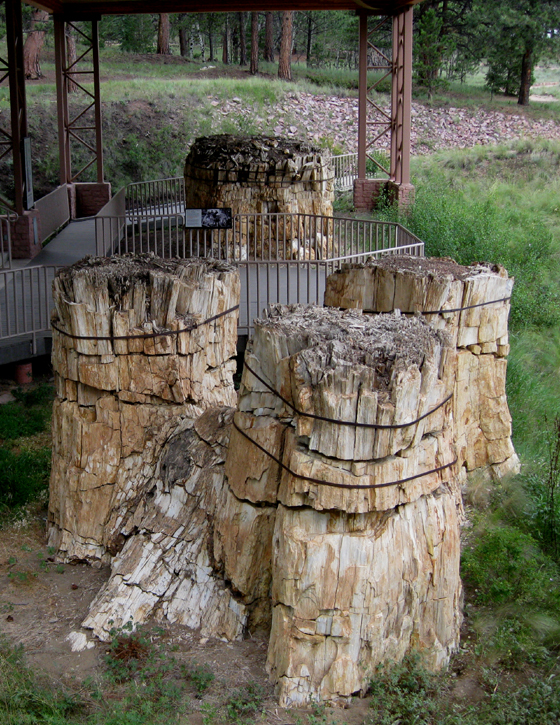
 |
 |
The
Florissant Formation: A Virtual Tour
Fossil
Preservation in the Lower Mudstone Unit |
 Sequoioxylon pearsalli “Trio” |
Very
different volcanic deposits preserved Eocene age life
at Florissant. A destructive lahar provided a geologic
environment in which wood became permineralized with
silica. The petrified wood at Florissant is found in
the lahar at the top of the mudstone. Although rare,
fossil leaf impressions and compressions can be found
in some parts of the mudstone. The delicate structures
of leaves and insects are more commonly found in the
shale units deposited within a lake environment. Fossil
trees in the main Petrified Forest represent Sequoioxylon,
which is
a name for fossil wood closely related to the Sequoia growing
along the coast of present day California. The largest stump
has a diameter of 4.1 m when measured at breast height
(1.5 m) above the ground. This size suggests a canopy height
of 60 m. We can infer from the preserved annual rings that
these redwoods were fast growing reaching diameters of 3 m
within 500 to 700 years (MacGinitie, 1953, p. 21). Fossil Sequoioxylon
pearsallii from Florissant has a higher mean ring width
when compared with the modern coast redwood (Sequoia sempervirens)
and the giant sequoia (Sequoiadendron giganteum),
indicating more favorable growing conditions for the fossil
trees. Two
of the fossil stumps have been cross-dated, which demonstrates
they grew in a single forest (Gregory-Wodzicki, 2001, p. 163).
Three interconnected stumps (known as the “Redwood Trio”)
share a root system and represent a clone. These
characteristics are very much like what is seen in present
day forests of Sequoia trees (Nudds & Selden,
2008, p. 214). The
lower mudstone unit has also produced evidence of mammals
including rodents, lagomorphs, insectivores, and ungulates.
Oreotalpa florissantensis is the oldest known occurrence
of a fossil mole (Family Talpidae) in North America (Lloyd
and Eberle, 2008, p. 539). Several even-toed ungulates
including the oreodont Merycoidodon and the deer-like Leptomeryx are represented at Florissant. Two odd-toed ungulates Mesohippus,
a three-toed collie-sized horse, and a species of Megacerops,
a large brontothere were also a part of the Florissant
fauna. The Florissant mammalian fauna indicates a Chadronian
or latest Eocene age for the Florissant Formation (Lloyd,
Worley-Georg & Eberle, 2008, pp. 122 & 123 and
Prothero and Sanchez, 2004, p. 146).
|
Bibliography |
Gregory-Wodzicki, K. M. (2001). Paleoclimatic Implications
of Tree-Ring Growth Characteristics of 34.1 Ma Sequoioxylon
pearsallii from Florissant, Colorado. In Evanoff, E., Gregory-Wodzicki
K.M. and Johnson, K.R. [Eds.] Fossil Flora and Stratigraphy
of the Florissant Formation, Colorado. (pp. 163-186). Proceedings
of the Denver Museum of Nature and Science, series 4, number
1. Lloyd, K. J., Worley-Georg, M.P., and Eberle J.J. (2008). The Chadronian mammalian fauna of the Florissant Formation, Florissant Fossil Beds National Monument, Colorado. In Meyer H.W. and Smith, D.M. [Eds.] Paleontology of the Upper Eocene Florissant Formation, Colorado. (pp. 117-126). The Geological Society of America, Special Paper 435. MacGinitie, H.D. (1953). Fossil Plants of the Florissant Beds, Colorado. Washington, D.C.: Carnegie Institution of Washington Publication 599. Mustoe, G.E. (2008). Mineralogy and geochemistry of late Eocene silicified wood from Florissant Fossil Beds National Monument, Colorado. In Meyer, H.W., and Smith, D.M., [Eds.], Paleontology of the Upper Eocene Florissant Formation, Colorado (pp. 127-140). Geological Society of America Special Paper 435. Nudds, J.R. & Selden, P.A. (2008). Fossil Ecosystems of North America: A Guide to the Sites and Their Extraordinary Biotas. Chicago: The University of Chicago Press. Prothero, D.R. and Sanchez, F., (2004). Magnetic stratigraphy
of the upper Eocene Florissant Formation, Teller County, Colorado.
In Lucas, S.G., Zeigler, K.E., and Kondrashov, P.E. [Eds.]. Paleogene
Mammals. (pp. 129-135). New Mexico Museum of Natural History
and Science Bulletin 26. |










